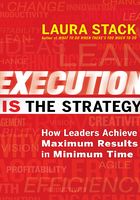
KEY 1 Leverage
L
LEVERAGE
Leadership Role Engineer: Build It
Development Opportunity Talent/Resources
When I was a kid, my younger brother Paul—who later graduated from college with a degree in mechanical engineering—taught me how using a lever could make building a snowman easier.
My father is a retired Air Force colonel. I grew up on the Air Force Academy in Colorado Springs, so I’m used to snow and lots of it. I remember one particularly big snowstorm that closed school and delivered perfect snowball-making snow. Paul and I naturally decided to make an enormous snowman.
We started with a huge base. Then we rolled a middle snowball nearly as large, and quickly discovered it was so heavy we couldn’t lift it. So my clever brother grabbed our Radio Flyer wagon and a wooden 2 × 8 beam from my father’s shed. Using the wagon as a fulcrum and the board as a lever, he lifted the middle snowball onto the base snowball while I guided it. After that, finishing our snowman was easy.
In the strictest mechanical sense, a lever is a simple machine with a rigid beam that pivots on a fulcrum or fixed hinge to magnify an input force, so the resulting leverage or output force can move heavy objects.
The concept of leverage fits equally well in the workplace, where applying it can facilitate smooth, on-the-spot strategic execution. The same basic components of leverage used to move a snowball apply to any business system. You can leverage physical and financial assets, experience, skill sets, specialized knowledge, and relationships to get the right people in the right roles. This means using the right tools to squeeze every bit of productive work from your team. It’s also the epitome of learning to do more with less—a powerful principle in today’s resource-poor workplaces.

An efficient organization is one that operates with leverage already in place:
• The Effort/Input Force = the leader (you)
• The Lever/Beam = the worker (employee or team)
• The Fulcrum/Pivot = the enabler (tool or resource)
• The Load/Object = your organization (what you’re trying to move with your strategy)
The interaction of these components is said to create leverage. Depending upon the strength of your strategy, the leverage created (the output force) can move the object (your organization). If the interaction of this simple machine with its component parts creates enough leverage, your organization will move where you want it to go. Without the right parts in place, movement will be much more difficult.
Put another way, the ability to lift the “snowball” in your organization requires increased input force. This is achieved either through a stronger leader, a longer and stronger beam (team members), or a fulcrum of more appropriate size, height, or position (tool or approach), or perhaps even a lighter snowball.
You’ll find it well worth the effort to develop or acquire the authority to leverage your resources and assets at will, not to mention those of your allies and partners. Why? Having the ability to apply the right amount of force at just the right time allows you to take advantage of fast-moving opportunities that may knock only once.
LEVERAGE IN ACTION
My two sons Johnny and James love to eat at the Chick-fil-A near our home. So I was delighted when Roger Blythe, Vice President of Business Analysis at Chick-fil-A, called upon me to work with his team at an upcoming department meeting.
When we chatted about the concept of leverage, Blythe told me,
There’s a lot of conversation around here about how to move more quickly. Even though we’re not under the pressure of bad financial results, we do constrain ourselves around the resources that we add every year. Our desires to continuously improve and add new features and services typically exceed the resources we can add in any given year, so there’s a built-in mechanism that forces us to try to become more efficient.
In my own area, we try to create as much clarity as we possibly can about the goal and what we’re trying to accomplish. Then we hire wonderful people—really smart, bright people who are engaged—and we give them a large amount of freedom and flexibility in executing that plan.
When you have the right people in the right roles and the right tools in place, the leverage gained makes implementing your strategic priorities far easier. So don your engineer hat, and let’s explore ways to build this simple machine so you can help your team execute with greater agility.